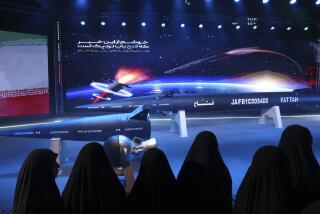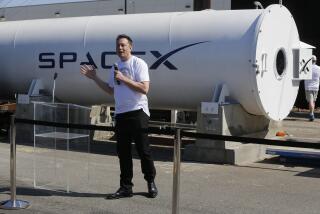Look Before You Leap
- Share via
For some years federal research agencies have been working on a so-called hypersonic airplane--an aircraft that would be neither a missile nor an airplane as we now know them, but would travel into the lower reaches of space at several times the speed of sound.
President Reagan, by calling for major expenditures on the hypersonic plane, has brought the project into the big league. His budget for fiscal 1987 calls for $150 million worth of research by the National Aeronautics and Space Administration and the Pentagon. Within 10 years the prospective bill, including an experimental model, is $3 billion.
With that much money involved, Washington really must separate rhetoric from reality. It can start by reviewing history.
The French, with British cooperation, built the world’s first supersonic airliner, the Concorde; it began commercial service ten years ago. The United States--fortunately, as it turned out--dropped out of that particular technological race. Whatever attraction the fuel-inefficient Concorde had for competitive airline operation was crushed when world oil prices skyrocketed in the 1970s.
Only 20 supersonic transports were produced. Today, the only Concordes in regular service fly between New York and Europe on Air France and British Airways.
The French are pressing U.S. manufacturers to help build and develop a second-stage supersonic airliner--a plane that would go 1750 miles per hour and carry two to three times as many passengers as the Concorde. But the Reagan Administration purports to be intrigued, instead, with the idea of leapfrogging the second-stage supersonic airliner and going forward with a plane that would go several times as fast.
In his State of the Union message Tuesday evening, the President gave the project his all-important imprimatur. In his words, “We are going forward with research on a new Orient Express that could, by the end of the next decade, take off from Dulles Airport in Washington and accelerate up to 25 times the speed of sound . . . flying to Tokyo within two hours.”
That’s all very exhilarating, but it badly misrepresents the facts.
Leaving aside the question of whether there is really a commercially viable demand for two-hour flights between Washington and Tokyo, the technological hurdles are immense.
The hypersonic aircraft or space plane, according to industry analysts, would have to carry three or more different propulsion systems--including one using dangerous, highly volatile liquid hydrogen, not only for fuel but for a coolant circulating through the airframe. And what about the noise and other environmental hazards?
The real impulse behind the hypersonic plane is not commercial but military. Managers of the President’s “Star Wars” program see it as a possible answer to their need for an affordable means of emplacing and maintaining space-based elements of an anti-missile defense system.
Maybe there is a case for pursuing research in this area. But Washington must recognize at the outset that a space plane, which could carry nuclear weapons as easily as passengers or space equipment, would pose serious new problems for arms control. Considering the pressures on the military budget, the project hardly qualifies for priority treatment.
To the degree that the Administration seriously wants to pursue technology that will keep U.S. aerospace companies in the forefront of the global trade in air transport equipment, the French proposal for cooperation makes sense. But in this area, as in others, the unfortunate truth seems to be that the President is peering into a looking glass and getting a purely military reflection.
More to Read
Sign up for Essential California
The most important California stories and recommendations in your inbox every morning.
You may occasionally receive promotional content from the Los Angeles Times.













